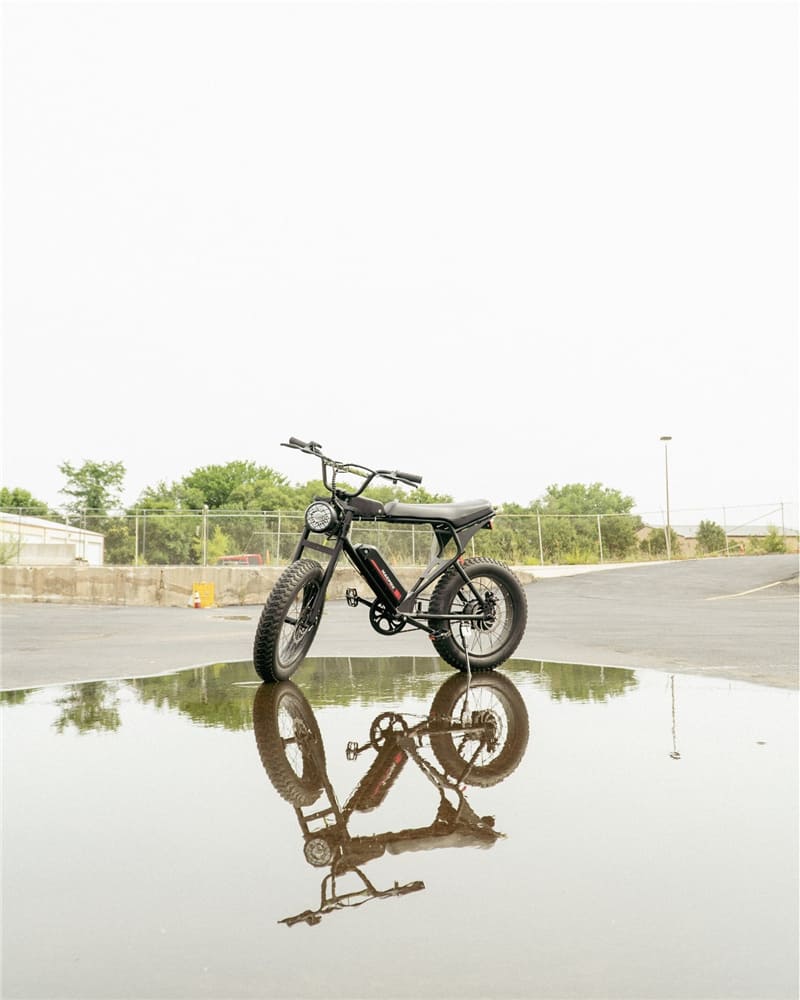Electric bikes use great versatility and charm, as evidenced by their growing appeal. Pedal-powered bikes and e-bikes have been in high need given the pandemic, with sales surging as more people function from home.
Although e-bike sales declined in 2023 from the previous year, e-bike sales were still up 238% in 2024 compared with 2019, according to market research firm Circana. They can be a great way to help cyclists who struggle with riding, extending their range and climbing abilities.
Advantages of Commuter E-Bikes over Traditional Bicycles

A traveler ebike is an electric bike created for sensible and sustainable transport. Traveling e-bikes offer several advantages over standard bicycles, consisting of:
- - Cost- Effectiveness: Electric bikes are cheaper to run and maintain than vehicles.
- - Environmental Sustainability: Commuting e-bikes generate fewer discharges than autos and other modes of transportation, making them a greener option.
- - Health Benefits: Commuting with an e-bike can aid you in staying active and remaining healthy.
- - Terrain versatility: Hybrid or electrical mtb are recommended for traveling depending on the terrain.
- - Reliability: Professional commuter bikes supply high-performance shifting and durability, guaranteeing you can rely upon them for daily usage.
In general, if you're seeking a practical and lasting method of commuting, a commuter e-bike is worth considering.
Different Types of E-Bikes to Consider
If you're considering getting an electric bike (typically called an e-bike), initially think of just how you intend to use it.
A current CR across the country representative survey of 2,035 U.S. grownups (February 2024) disclosed that 11% of Americans have ridden an e-bike in the past year.
The survey likewise discovered that among those who had ridden an e-bike or e-scooter in the past year, fun and pastime were among the reasons that 71% chose to ride an e-bike or e-scooter.
There are almost as many types of e-bikes as pedal-powered bikes, and many can do certain tasks well.
A crucial factor in your decision will be where you live. The environment, the existence (or lack thereof) of bike lanes, how much you want to ride regularly, and how e-bikes are categorized and managed in your area will all impact your travels.
Most U.S. states consider e-bikes as a type of bicycle, depending on how fast they take a trip and how power is used (such as via pedals or manual controls).
However, some states deal with e-bikes like other cars and require cyclists to have an operator's license to utilize them on public roadways, depending on the kind.
Currently, there are three general categories (PDF) of e-bikes and some grey areas.
Course 1 covers pedal-assist bicycles, which power an electric motor when your foot uses pressure on the pedals. There's no throttle to get the bike relocating; the electric section only functions when the cyclist pedals, and the digital help turns off at rates over 20 mph. (It's feasible to go faster on a traditional bike than down a steep hill.).
Level 2 bikes likewise feature electric motors that run up to 20 miles per hour, whether the motorcyclist pedals (pedal aid) or utilizes electric propulsion alone using throttle control.
Level 3 restrictions e-bike pedal-assisted rates to 28 miles per hour and needs a speedometer.
Where you can ride an e-bike varies from location to location, so it's a good idea to check neighborhood regulations before using an e-bike on a specialized bike path.
We likewise highly suggest that e-bike motorcyclists use headgear if it is not required in your area.
There are additionally extra effective e-bikes that can just be ridden in assigned off-road locations. These electric bikes look like bikes but function more like motorcycles.
Why Choose the Electric Bike for Traveling?
There are several reasons that individuals acquire e-bikes; however, after talking with professionals and cyclists, we found that the main ones are for traveling, recreation, and carrying light cargo.
For many during the pandemic, cycling has been a transport option for urban and country commuters looking to stay clear of public transportation. Besides maintaining social distancing, they are terrific for working and enjoyable, despite the assistance of electrical motors.
"Electric bikes appeal to a diverse range of riders," notes Sarah Johnson, a cycling expert and former owner of an e-bike shop in Omaha, Nebraska. "They're chosen by young individuals who prefer not to own cars, by older adults seeking a bit of assistance to continue cycling, and by commuters who wish to arrive at work without breaking a sweat."
National study information shows more than half of individuals's journeys are 3 miles or less, according to the Department of Transportation. 72% of these are made from automobiles; much less than 2% are made from bicycles.
The National Conference of State Legislatures (NCSL) states the range is viable on bicycles, specifically e-bikes.
An electric bike like the Macfox X1, with a 500 W motor and 48V 10.5 Ah battery, is perfect for hilly cities.
Hybrid electric bikes or electric mountain bikes can be great for touring, depending on the terrain they cover.
With electrical power pedals, you can get to your location quickly without exerting a great deal of effort while also aiding the setting.
Commuting e-bikes are a practical method to stay healthy and balanced while minimizing commuting prices in the long run.
Related Reading: Electric Bike Camping Adventure Guide
Electric Bike Pricing
Electric bikes range in rate from less than $500 to countless bucks. For many consumers, the luxury is around $6,000 to $7,000.
According to NCSL, the typical rate of an electric traveler bike is $2,000 to $3,000, compared to $1,000 for a typical mid-range commuter bike.
For example, the X1 commuter bike launched by Macfox is valued at between US$ 999-1,497.
Macfox X1
$999.00 – $1,497.00Factors to Consider When Choosing a Commuter E-Bike
There are several aspects to consider when picking an electric bike for traveling.
First and foremost, e-bikes save cash in the future because of their reduced running costs.
Additionally, they offer ease and comfort for traveling, avoiding sweat and traffic congestion.
By using an e-bike, you can additionally contribute to a sustainable atmosphere by reducing your carbon exhaust.
Crossbreed bikes are suitable for flat surfaces and much shorter distances, while hill e-bikes are made for rough surfaces and longer commuting ranges.
When picking the right e-bike, you need to consider the terrain of your commute.
E-bikes are tidy, eco-friendly, and affordable, perfect for personal transportation.
If you intend to conserve cash and make your daily commute more convenient and environmentally friendly, consider purchasing an electric commuter bike today!
Battery Life and Power
When choosing an e-bike for traveling, there are several elements to consider to guarantee you find the best fit. A vital factor is the bike's battery life and power.
The Macfox X1 e-bike's 48V 10.5 Ah lithium-ion battery provides over 38 miles of range in pedal help mode or 76 miles on double batteries. This suggests you can quickly commute to and from leave work without needing to bother with lacking battery.
E-bikes with powerful electric motors and batteries can drive commuters to accelerate to 15.5 mph/25 km/h, flatten hillsides, and give a rejuvenating ride to work.
Electric bike batteries come in numerous voltages, such as 36V, 48V, 52V, and so on, and can be charged with a battery charger.
A battery capacity of 250Wh or higher is suggested for forever range on hybrid e-bikes; real variety will depend on riding problems and help level.
The removable battery on the Macfox electric bike makes charging simple and practical, ensuring you're all set for your next adventure.
Motor Type and Power
When choosing a commuter ebike, numerous elements exist, including electric motor type and power.
Degree 3 e-bikes include a 750-watt electric motor and can reach a top speed of 28 mph/45 km/h, while Level 1 e-bikes can be ridden at rates of approximately 20 mph.
Traveling e-bikes can help you avoid the headaches of a standard bike, enabling you to function more conveniently and feel freshened at speeds up to 15.5 mph/25 km/h.
The Macfox X1 traveler electric bike is a good selection, with a 500W back wheel hub drive motor and an LCD show. Its semi-integrated battery design makes it simple to get rid of and replace.
Ultimately, when choosing a commuter e-bike, you must consider your specific requirements and find a choice that fits your lifestyle.

Safety Precautions for Electric Bicycles
E-bikes can take a trip at comparable speeds to standard bicycles, bringing the same security risks. Nevertheless, versions capable of traveling at 20 mph or more add risk.
Greater speeds mean less time for motorcyclists to reduce or quit. Whether on a bicycle or bike, even low-speed collisions, especially when involving cars and vehicles, can be uncomfortable or even deadly.
A 2019 study in the journal Injury Prevention found that e-bike riders were more likely to suffer internal injuries than those on standard bicycles, based on a review of emergency clinic documents.
The simplest and most apparent way to prevent severe head injuries is to wear a bicycle headgear.
A 2007 review of bike helmet research released in the journal Injury Prevention discovered that putting on headgear can minimize the possibility of significant head injury by 63 to 88 percent. Using brilliant garments and following website traffic policies can also assist.
Another important safety and security aspect of biking is the accessibility of dedicated and particularly secured bike lanes.
If you should drive your vehicle when traveling, think about the speed and web traffic volume at the time. Vehicle drivers may be sidetracked or drive as well fast and not see the biker.
There are aftermarket tools that can be added to any bike and that work similarly to energetic vehicle driver assistance systems (ADAS) found in cars and trucks. These include dead spot caution and accident detection.
There hasn't been much scholarly research on the threat of injury to youngsters from the most up-to-date e-bikes, yet it's best to be extra careful when catering to new or unskilled cyclists.
Any individual who diminished a bike as a youngster knows that low-speed collisions and rollovers can also cause injuries.
Considering that a lot of e-bikes make use of lithium-ion batteries, there are also fire risks to take into consideration. Utilizing the appropriate charger and charging cable provided by the bike producer you have is essential.
If, for some reason, you end up needing to change the battery, use only UL-listed batteries approved by the bike manufacturer.
Do not leave your bike ignored while charging; do not charge your e-bike in a sleeping area or where it might block area or structure accessibility.
Lithium-ion battery fires are rare but can be major. They are usually caused by improper charging or storage space.
Conclusion
Traveling e-bikes are a superb alternative for those who wish to minimize their carbon footprint and save money on transport costs.
They provide a series of advantages over typical bicycles, including a simpler commute, much less physical effort, and the ability to take a trip for longer distances.
Nevertheless, there are several e-bikes on the marketplace, so factors such as battery life, motor power, durability, and convenience must be considered when choosing an e-bike.
FAQs
What are the principle benefits of using a commuter ebike?
Commuter e-bikes are price-powerful, environmentally friendly, and promote bodily health. They also allow for less complicated navigation through town visitors.
Do I want a license to trip an e-bike?
License necessities vary by means of nation and e-bike magnificence. Generally, Class 1 and 2 e-bikes do now not require a license, at the same time as Class three might. Always check nearby legal guidelines.
How long does the battery ultimate on a commuter e-bike?
Battery existence normally degrees among 20-100 miles in step with rate, relying at the model and utilization situations. Higher potential batteries offer longer range.


















